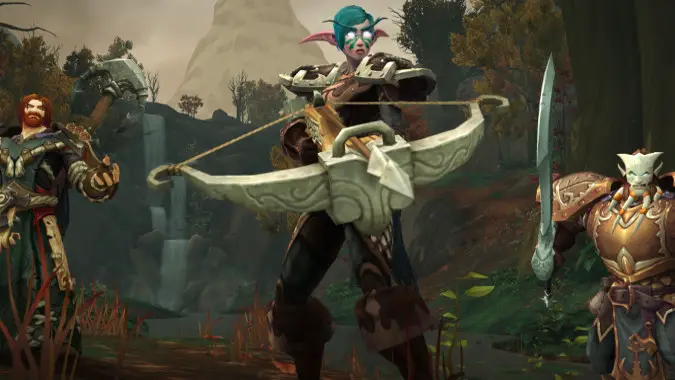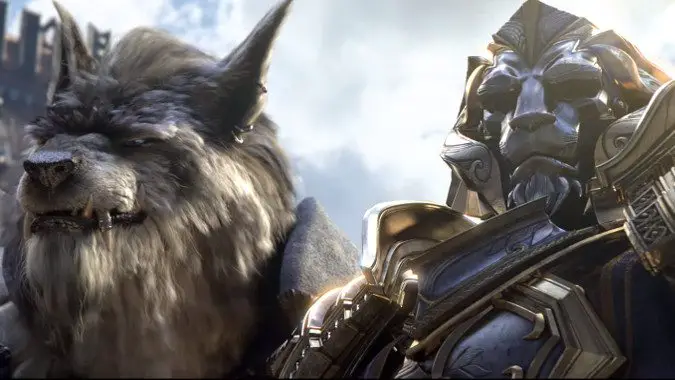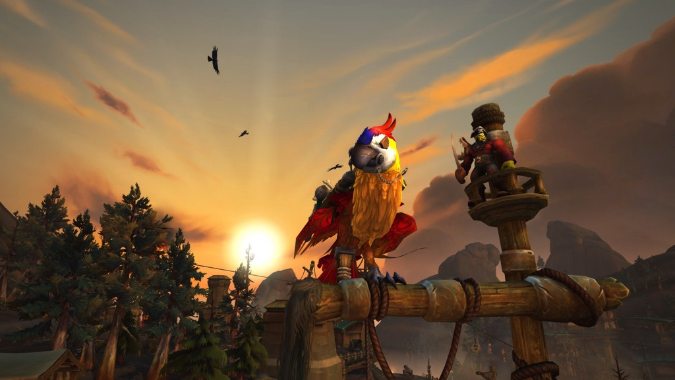Blizzard discusses Battle for Azeroth class design in latest dev watercooler

If you’ve been playing WoW for a while, you’re familiar with the way each class sees design changes with the coming of a new expansion. But what can we expect in Battle for Azeroth? The latest dev watercooler talks about just that.
Focusing on uniqueness
Over the past few expansions the design of World of Warcraft has shifted towards making sure that if an ability is considered crucial or situationally strong — such as Bloodlust/Heroism or AOE stuns — more than one class has the ability to provide that ability. But now the designers are looking at how that can make classes feel homogeneous. For class identity to feel unique it’s okay for certain classes to bring an ability that benefits their group in a unique way. This design goal feels very much like a return to vanilla WoW to me, and time will tell how it plays out.
But on the whole I agree with the idea of class uniqueness needing a bit more focus. As a Warrior player, I’m a bit tired of seeing Execute handed out like candy to other classes, and Paladins getting Whirlwind when Blizzard could have focused on making Consecrate into a useful AOE DPS move has always bothered me. I’m sure a little bit of differentiation between classes can be a good thing and I’m interested in seeing how Blizzard goes about it.

A talented bunch
Talent design in Battle for Azeroth isn’t going to be the radical redesign we saw at the dawn of Mists of Pandaria. We’re likely to see smaller scale changes focused around giving each class choices that are meaningful without feeling like there’s a clear, mathematical winner or that you’re required to switch talents between each fight depending on AOE vs single target applications.
Of course if you’ve played for a while you’ve heard this before, but that doesn’t mean it’s not a good goal to have, and it’s reassuring that we’re likely not going to see any class design changes as sweeping as renaming a spec and redoing half their talents. Although I still feel like leaving two classes with Restoration and two classes with Protection specs was a big mistake and the loss of a golden opportunity, Blizzard.
Blizzard paid specific attention to talents that affect pacing — i.e. talents that speed up, slow down or otherwise change your rotation. These talents will continue to exist, because when they work out they’re fun for players. But Blizzard will try to rein them in and focus on only a few of them so we don’t end up feeling like a talent choice utterly alters our rotation to the point where it’s either necessary or burdensome.

What about Artifacts?
Blizzard is aware that many specs have come to rely on Artifact abilities, but the temporary nature of Artifacts was always part of their design. Developers felt free to make the Artifacts meaningful and flashy because they knew players would be moving on from them. While they’re aware that in some cases rotations are going to feel empty without certain Artifact traits, they’re not just going to shove every Artifact ability into each class. But they will be looking for ways to compensate for any dead zones in players’ rotations once Battle for Azeroth removes the Artifacts entirely.
And they are looking for some abilities that will make the jump, because they aren’t blind to the impact Artifacts have had on some classes. It’s going to be a high bar to clear, because some abilities were deliberately made big and sweeping entirely because of that transient, expansion-defining role that Artifacts play, but the developers are paying attention to the problem.
Some abilities may also make a comeback in the Azerite Armor and Heart of Azeroth systems.
It’s good to see Blizzard’s thinking on these elements of the class design, and hopefully we’ll see more of how it plays out sooner than later. Read the full post below for all the details.
The development of World of Warcraft: Battle for Azeroth is well underway, and we want to share some insights into our philosophies and approach to class design for the expansion. While the launch of Legion brought lots of change to all of Warcraft’s classes, Battle for Azeroth will more closely resemble the example set by Legion’s patch content: targeted iteration based on player feedback and data.
The intro cinematic of Battle for Azeroth revealed at BlizzCon 2017 has an underlying theme that resonates deeply with the class design team: “Remember what makes us strong.” With that in mind, our goals for the next expansion are to promote what makes each class unique, focus on making group gameplay the best that it can be, and continue our efforts to improve combat visuals and effects. While we believe some specializations will need substantial iteration to achieve these goals, others will not, and our target is greater stability across the board.
Class Uniqueness and Utility
One area we’re trying to focus on across all classes is to better emphasize what makes each class unique and provide greater distinction among their various capabilities, especially when it comes to utility—tools that fall outside of core role functions like damage, healing, or mitigation. Part of what makes you feel excitement and pride in your class is pulling off a heroic moment and feeling the appreciation of your group when individually contributing to a shared success. That feeling is eroded when so many classes bring similar abilities, and you feel you’re rarely providing something distinctive. More differentiation in this area will create situations where another class can do something that you can’t, but you will similarly bring tools to the table that your allies lack.
That contrast causes members of a team to be more dependent on each other to succeed, and encourages different group compositions to approach encounters in different ways.
Pursuing this goal will likely involve adding some new abilities (or re-adding previously removed abilities) to give classes a more unique signature where needed. It will also likely involve reining in the availability of certain utility types, especially those that are so widespread that they rarely provide meaningful contrast between classes. As a notable example, Area of Effect (AoE) stuns, some of most powerful utility that exists, are so abundant that most groups have at least one or two. As a result, decision-making around that tool is often less about when it would be best used, and more about avoiding overlap with other AoE stuns. Not only does this sometimes drown out the importance of other crowd control in dungeons, but it means that a class bringing an AoE stun to a group is not the major strategy-defining asset that it should be. Our goal is that whatever powerful kind of utility a class brings, it’s something that group will be happy to have added to their toolbox as they approach a challenge.
The goal of contrast between the abilities of different specializations is not limited to utility. We’re also looking at different specializations’ strengths and weaknesses in their “main role”—damage dealing (or DPS), healing, or tanking—and making sure everyone has something to get excited about and an opportunity to shine. Some DPS specializations are “bursty,” doing fast damage; some live for attrition, wearing away their target. Some specializations prefer to isolate and drill into a single threat, while others revel in blowing up huge packs of monsters. Much of this plays out naturally due to the varying sets of damaging abilities, but we are working more intently than in the past to ensure an appropriate variety and spread of DPS strengths and weaknesses. Likewise, healers and tanks should have a bit more identity through their unique healing and mitigation profiles.
Another part of this approach involves working with our content design teams to collaborate on a world where quests, dungeons, and raids create opportunities for all different types of class strengths to shine. If we’re arming classes with distinct tools that provide powerful answers to different situations, it’s important that the game’s content provides a broad array of challenges that play into those different tools.
Talent System Refinements
The overall talent system will remain largely unchanged, but we will be refining our approach. One of the major challenges in setting up talent rows is that they serve two conflicting desires: choices within a row should be meaningfully varied, but also should not feel like they are simply a test of which is best in a particular setting.
If a row has three similar area-damage talents, your decision can feel like it boils down to a complex math problem. If a row mixes area-damage and single-target talents, you’ll likely feel you should change talents to suit the content you’re doing, which also rarely feels like a choice. The most successful talent rows are those with options that have a generally consistent role in your toolkit, but have very different delivery and mechanics, allowing players to thoughtfully customize their identity and complexity.
One other lesson we’ve already begun implementing in Legion patches is being careful with the effect that talents have on “pacing”—how frequently you get to press your buttons, and how often you generate resources and cooldowns. Of course, many talents affect the pacing of a rotation, and this will continue to be the case, as these are some of the talents with the most noticeable and fun feel to them. But if you have access to multiple talents that slow down or speed up your rotation, players can end up outside the bounds of what feels good to play (for example, by being resource starved or flooded). As we review talents going forward, we will try to avoid this by having strong resource-generating talents compete with each other, and better limiting the pacing change allowable from any single talent.
Artifacts Here and Gone
One particular challenge for the class design team throughout Legion was handling the introduction and eventual removal of Artifacts. The idea was exciting: design a large set of bonuses with the intention that they would be contained within an expansion, allowing us to make them flashier, more complex, and more numerous than we’d been able to in a specialization’s permanent set of core abilities. But the process of parting with Artifacts produces a complex set of decisions about how to adjust the base classes to play well in their absence.
The largest issue is where the pacing of a spec’s rotation was heavily affected by Artifacts. In that case, removing the Artifact may result in a rotation that’s too slow, or has too much open time where the core buttons aren’t available. In the process of reviewing and updating each specialization for Battle for Azeroth, we want to make sure all of them are paced appropriately after the removal of Artifacts. In some cases, we may do things like increase resource generation or reduce cooldowns to fill in some of the newly opened space.
For traits that go beyond simple numerical changes and have their own identity—such as active abilities or the powerful and noticeable procs—we are on the lookout across all specs for a small selection of traits that are worth turning into permanent parts of a class. The bar is high for a trait to become permanent. It’s an intended part of the experience of a system like Artifacts that the bonuses are layered on top of the core functionality of your class. You get to explore those bonuses thoroughly, but eventually move on from them. That leaves space in the permanent classes for new special bonuses from other systems in the future, as we’ll soon be exploring with Azerite Armor. That said, various specs will likely see one or two familiar traits from Artifacts showing up in their talent trees in Battle for Azeroth.
These are the broad philosophies that are guiding our design in Battle for Azeroth, and we were deliberately light on sharing specific examples of change, which are still in a state of flux at this stage. We welcome a community discussion on the principles we’ve outlined, and look forward to delving into detailed and specific changes as we move forward with our beta testing in the near future.
Please consider supporting our Patreon!
Join the Discussion
Blizzard Watch is a safe space for all readers. By leaving comments on this site you agree to follow our commenting and community guidelines.
 @MatthewWRossi
@MatthewWRossi



